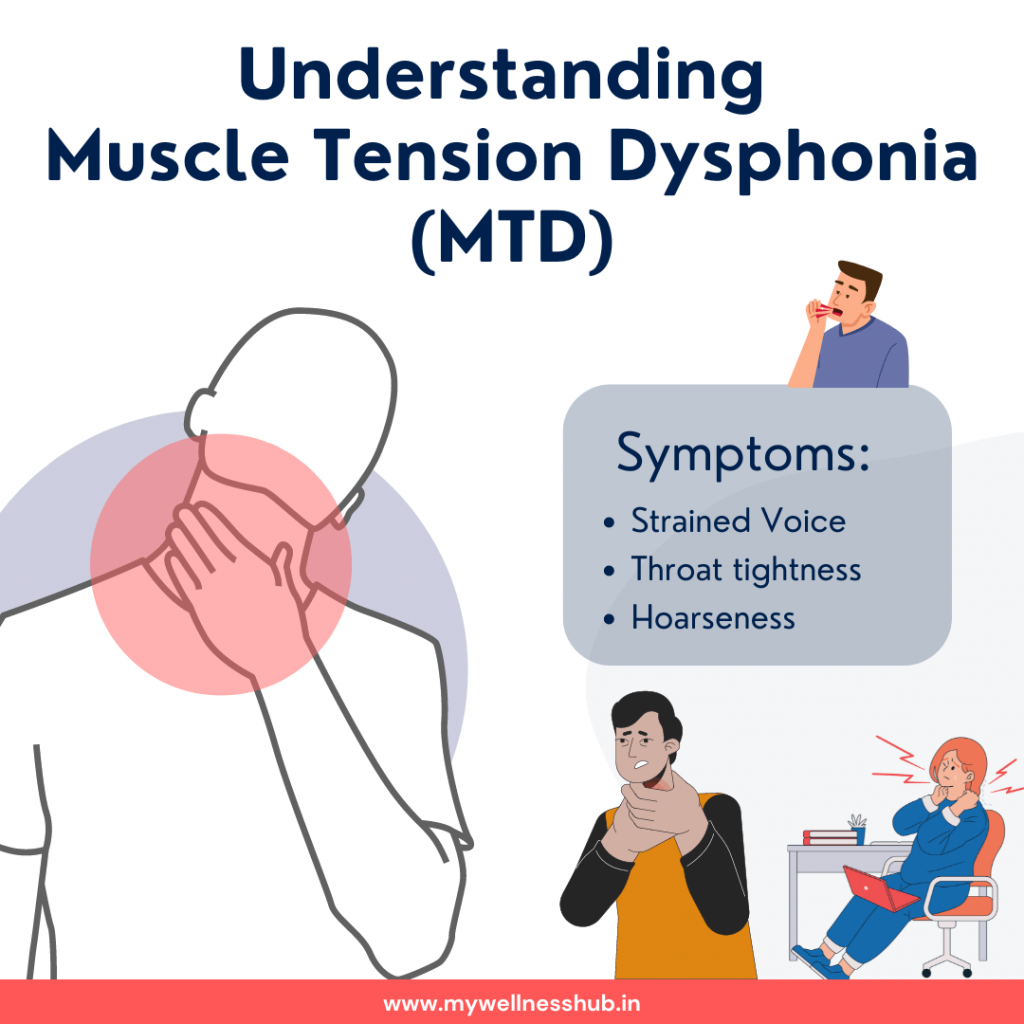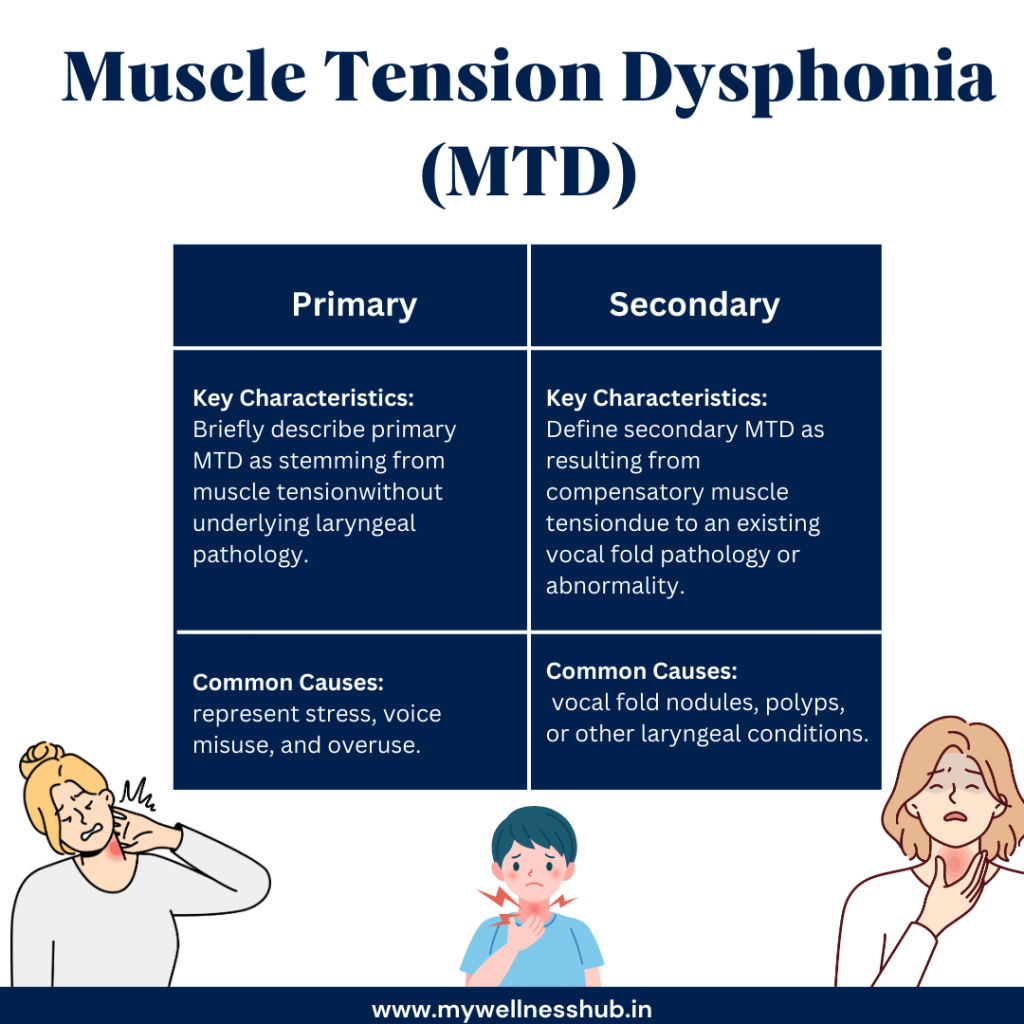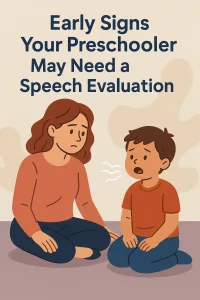Muscle Tension Dysphonia: How to Spot It & Find Relief
By Rajini D
Last Updated: April 11, 2024
Have you ever tried to speak but found your voice uncooperative, reduced to just a whisper or an unrecognizable harsh tone? It’s more than just frustrating; it can be a daily battle for those with Muscle Tension Dysphonia (MTD). This voice disorder is increasingly common, exacerbated by our high-demand, digital lifestyles. From professional speakers to anyone using digital devices, MTD turns simple conversations into exhausting efforts. Today, we’ll explore what Muscle Tension Dysphonia is, why it’s becoming more prevalent, and how you can manage or even overcome it. Join us as we learn how to ensure your voice remains a true reflection of yourself.

What is Muscle Tension Dysphonia?
Have you ever had one of those days where your voice just didn’t seem to cooperate? Maybe it sounded strained, or perhaps speaking felt more difficult than usual. If so, you might have experienced something called Muscle Tension Dysphonia, or MTD for short. Let’s break it down into simpler terms to understand what’s happening behind the scenes.
Imagine your voice as a musical instrument that relies on various parts working in perfect harmony. For a smooth, melodious sound, everything needs to be in sync, especially your breathing and muscle movements. MTD happens when this coordination goes off-track. Specifically, it occurs when there’s too much pressure on the muscles around your larynx (that’s your voice box), making your voice sound tight or strained. It’s like trying to play a violin with a bow that’s too tight: the music just won’t sound right.
Now, MTD isn’t a one-size-fits-all issue. It comes in two main types: primary and secondary.
- Primary MTD is when the muscles in your neck tense up while speaking, but there’s no visible issue with your larynx itself. It’s a bit like feeling the strain in your arm muscles when you’re holding something heavy, but the object itself isn’t the problem.
- Secondary MTD, on the other hand, is when there is an actual issue with your larynx that causes you to overuse other muscles to compensate. Imagine if one of the strings on that violin was out of tune, and you had to adjust your bowing technique to try and get the right sound. It’s extra effort and can lead to strain.

Understanding MTD is the first step toward addressing it. Whether it’s the primary or secondary type, recognizing the symptoms early on can make a significant difference in how you manage and treat this voice disorder.
Also read: Understanding Speech Delay: Causes, Milestones, and Therapy
Signs and Symptoms to Watch For:
- Strained Voice: Does your voice frequently sound tense or strained, as if you’re lifting a heavy weight with your vocal cords?
- Hoarse, Breathy, or Rough Voice: Do you notice a persistent hoarseness or a breathy quality to your voice that wasn’t there before?
- Tightness in the Throat: Is there a sensation of tightness or constriction in your throat that makes speaking uncomfortable?
- Sudden Breaks in Voice: Have you experienced unexpected breaks in your voice, where it cuts out or cracks unexpectedly during a speech?
- Neck Discomfort: Do you find the muscles in your neck are often tender or sore to the touch?
- Frequent Throat Clearing: Is there a persistent need to clear your throat despite not feeling ill?
- Sensation of a Lump in the Throat: Have you felt what seems like a lump in your throat, making swallowing or speaking feel awkward?
These symptoms can be more than just annoying; they can significantly impact your day-to-day life, from work to social interactions. It’s not just about a temporary change in your voice or a once-off sore throat; MTD symptoms persist, creating a constant battle between you and your voice.
Comparing Symptoms: MTD vs. Other Voice Disorders
| Symptom | Muscle Tension Dysphonia (MTD) | Vocal Nodules | Laryngitis |
|---|---|---|---|
| Strained or Tight Voice | Common | Sometimes | Rarely |
| Hoarseness | Very Common | Very Common | Very Common |
| Frequent Throat Clearing | Common | Less Common | Common |
| Sensation of a Lump | Common | Rarely | Less Common |
| Voice Fatigue | Very Common | Common | Common |
| Persistent Cough | Less Common | Rarely | Common |
| Loss of Voice Range | Common | Very Common | Common |
| Breathiness | Common | Common | Very Common |
| Pain or Discomfort | Less Common | Rarely | Very Common |
| Sudden Voice Breaks | Common | Sometimes | Sometimes |
Learn more: Speech Sound Disorders: Causes, Treatment and Strategies
Reflect on Your Experiences
As you read through these symptoms, think back to your own experiences. Have you noticed any of these signs persisting longer than they should? It’s not uncommon to overlook these symptoms, attributing them to tiredness or a minor cold. However, if these symptoms are a regular part of your life, they could be hinting at something more, like Muscle Tension Dysphonia.
Common Causes and Contributing Factors
Diving deeper into Muscle Tension Dysphonia (MTD), it’s essential to uncover the root causes and contributing factors. Understanding “What causes Muscle Tension Dysphonia in adults?” can illuminate why this condition might be affecting you or someone close to you.
- Lifestyle Factors: Our daily habits and work environments play a significant role. For instance, individuals who use their voice extensively for work—teachers, singers, and call center employees—may experience MTD due to the constant strain. Similarly, speaking loudly in noisy environments or without adequate breaks can contribute to the development of MTD.
- Medical Conditions: Certain health issues can predispose individuals to MTD. Acid reflux, for example, can irritate the throat and larynx, leading to muscle tension as a protective response. Upper respiratory infections, allergies, and thyroid conditions also play a role by directly affecting throat muscles and vocal cords.
- Psychological Stress: Emotional stress and anxiety aren’t just mental health concerns; they physically manifest in our bodies, including our voice muscles. The tension from stress can lead to tightening around the larynx, contributing to MTD.
- Incorrect Vocal Techniques: Using the wrong techniques to project your voice can put undue strain on your vocal cords and surrounding muscles, leading to MTD. This is often seen in people who have not been trained in proper vocal projection and breathing techniques.
Diagnosing Muscle Tension Dysphonia
The journey to diagnosing MTD involves a blend of art and science, primarily due to its elusive nature. Since there’s no single test for MTD, a comprehensive evaluation by a specialist is crucial.
- The Role of Specialists: Diagnosis typically begins with a visit to a speech-language pathologist or an ear, nose, and throat (ENT) doctor. These professionals have the expertise to assess the nuances of voice disorders.
- Examination Process: The diagnosis process may include a detailed medical history review, a physical examination of the throat and neck, and specific tests like videostroboscopy. This procedure allows specialists to see the vibrations of the vocal cords in slow motion, revealing any abnormalities in their movement or structure.
- Challenges in Diagnosis: One of the main hurdles in diagnosing MTD is its symptoms’ similarity to other voice disorders, making it easy to misdiagnose. That’s why a thorough and holistic approach by experienced professionals is indispensable.
Effective Treatments and Therapies

Navigating the path to managing Muscle Tension Dysphonia (MTD) can lead to a significant improvement in quality of life. One of the most effective and widely recommended treatments is voice therapy. Conducted by experienced speech-language pathologists, voice therapy involves tailored exercises designed to strengthen your vocal cords, improve breathing and speaking techniques, and ultimately reduce the strain on your voice. It’s not just about getting your voice back but about rediscovering it in a way that’s healthy and sustainable.
Voice therapy sessions might include techniques for:
- Breath support: Learning to use your breath efficiently to power your voice without straining.
- Vocal exercises: Tailored exercises that help balance the muscular effort across your vocal system.
- Relaxation techniques: Strategies to relieve tension in the muscles around the larynx (voice box).
Self-Care and Management Strategies
While professional treatment is paramount, incorporating self-care practices into your daily routine can further alleviate symptoms and prevent recurrences. Here are some practical tips aligned with Wellness Hub’s holistic health philosophy:
- Hydration is Key: Keep your vocal cords well-hydrated by drinking plenty of water. This can help prevent voice strain and maintain vocal health.
- Warm-Up Your Voice: Just like warming up before a physical workout, vocal warm-ups can prepare your voice for the day ahead, reducing the risk of strain.
- Mind Your Environment: Try to minimize shouting or speaking loudly over background noise. Use a microphone if you’re addressing a large group to avoid overstraining your voice.
- Take Vocal Breaks: Rest your voice periodically, especially on days of heavy use. Silence can be golden for vocal recovery.
- Stress Management: Since stress can tighten the muscles around your voice box, finding effective ways to relax and unwind is crucial. Practices like yoga, meditation, or deep-breathing exercises can be incredibly beneficial.
By combining professional guidance with diligent self-care, managing Muscle Tension Dysphonia becomes a more navigable journey. Whether it’s through voice therapy, exploring additional treatments like Botox or laryngeal massage, or implementing practical self-care strategies, relief from MTD is within reach.
Read more: Unlocking Communication: Effective Speech Therapy for Autism
Effective Vocal Exercises for MTD Management
| Exercise Name | Description | Benefits |
|---|---|---|
| Humming Warm-Up | Start by humming a comfortable note and then gently slide up and down the scale. | Warms up the voice, reduces strain, and improves vocal cord closure. |
| Lip Trills | Keep your lips relaxed and blow air through them to create a trilling sound. Move up and down your vocal range while maintaining the trill. | It relaxes vocal cords and throat muscles and improves breath control. |
| Yawn-Sigh | Begin with a deep yawn to stretch the throat, then release into a gentle sigh on exhalation. | It relieves tension in the throat and vocal cords, and encourages relaxation. |
| Straw Phonation | Hum or sing through a straw into a glass of water, focusing on steady, smooth airflow. | It relieves tension in the throat and vocal cords and encourages relaxation. |
| Resonant Voice Exercises | Produce a clear and strong voice at a comfortable pitch and loudness level by focusing on feeling vibrations in the front of your face. | Enhances vocal resonance and reduces effortful phonation. |
Explore more on our article Speech Therapy at Home: Top Tips For Parents
When to Seek Professional Help
Recognizing when it’s time to seek professional help can be a crucial step in your journey toward vocal health. While it’s normal for our voices to feel tired after a long day of talking or if we’re recovering from cold, persistent symptoms that interfere with our daily life warrant a closer look. Here’s how to know when it’s time to consult a specialist:
- Persistent Voice Changes: If you notice consistent changes in your voice, such as hoarseness, strain, or loss of vocal range, that last for two weeks or more, it’s time to seek professional advice.
- Vocal Fatigue: Experiencing fatigue or discomfort during or after speaking, which doesn’t improve with rest, indicates underlying issues that a specialist needs to assess.
- Physical Discomfort: Sensations like throat tightness, the need to frequently clear your throat, or feeling a lump in your throat are signs that shouldn’t be ignored.
- Effortful Speaking: If speaking feels effortful or you find yourself having to force your voice out, it’s an indication that your vocal cords or associated muscles aren’t functioning optimally.
Finding the Right Specialist
Seeking help from the right healthcare provider is crucial. A speech-language pathologist or an ear, nose, and throat (ENT) doctor specialized in voice disorders can offer the expertise needed for diagnosing and treating Muscle Tension Dysphonia. These professionals can provide a comprehensive evaluation and tailor a treatment plan suited to your specific needs.
How Wellness Hub Can Help
Understanding the need for reliable and accessible health information, Wellness Hub stands as a beacon for those seeking guidance on their health journey. Our platform offers resources and information on a wide array of health topics, including Muscle Tension Dysphonia. Whether you’re looking for tips on managing symptoms or seeking to connect with a specialist in your area, Wellness Hub can provide the support you need.
Conclusion
In conclusion, understanding and addressing Muscle Tension Dysphonia is crucial for maintaining a healthy voice. By staying informed, you can spot the early signs, seek effective treatment, and manage your vocal health with confidence. Remember, every voice deserves care and attention. At Wellness Hub, we’re committed to supporting you on your journey toward vocal well-being. Whether you need expert advice, practical self-care tips, or a supportive guide, we are here to assist you. Let this knowledge empower you to nurture a resilient and vibrant voice, ensuring you can communicate freely and comfortably in all aspects of your life.
Frequently Asked Questions:
1. What is Muscle Tension Dysphonia (MTD)?
Muscle Tension Dysphonia is a voice disorder that occurs when there’s excessive tension in the muscles around the larynx (voice box), leading to voice changes such as hoarseness, strain, or a tight feeling in the throat. It can affect anyone who uses their voice regularly, not just professional singers or speakers.
2. What are the signs and symptoms of Muscle Tension Dysphonia?
Common symptoms include a strained or tight voice, hoarseness, frequent throat clearing, a sensation of a lump in the throat, and discomfort or aching in the throat and neck area. If these symptoms persist for more than two weeks, it’s advisable to seek professional evaluation.
3. How is Muscle Tension Dysphonia Diagnosed?
MTD is diagnosed through a comprehensive evaluation by a speech-language pathologist or an ENT doctor, which may include a review of medical history, physical examination, and specialized tests like video stroboscopy to examine the vocal cords’ vibration.
4. What treatment options are available for Muscle Tension Dysphonia?
Voice therapy with a qualified speech-language pathologist is the primary treatment. It focuses on exercises to improve vocal cord function and reduce tension. Other treatments can include laryngeal massage, stress management techniques, and, in some cases, Botox injections to relax the muscles around the larynx.
5. Can Muscle Tension Dysphonia be cured?
While MTD is a manageable condition, its outcome depends on various factors, including the underlying cause, the individual’s commitment to treatment, and adherence to voice therapy exercises and recommendations. Many individuals see significant improvement with the right approach.
6. How can I prevent Muscle Tension Dysphonia?
Preventative measures include staying hydrated, using proper vocal techniques, taking regular vocal breaks, especially during prolonged speaking or singing, and managing stress. It’s also important to seek treatment for any underlying conditions that might contribute to voice strain.
7. How long does it typically take to see improvement after starting treatment for Muscle Tension Dysphonia?
Improvement timelines can vary, but many individuals begin to see positive changes within a few weeks of starting voice therapy. Consistent practice of the prescribed exercises and adherence to therapy recommendations are crucial for recovery.
8. What lifestyle changes can help manage Muscle Tension Dysphonia?
Adopting a healthy lifestyle that includes adequate hydration, regular voice rest, and stress reduction can significantly help manage MTD. Avoiding smoking and minimizing exposure to pollutants is also beneficial.
9. Can speaking techniques improve Muscle Tension Dysphonia?
Yes, proper speaking techniques, such as breath support and avoiding speaking at extreme pitches, can alleviate strain on the voice box and improve symptoms of MTD. Voice therapy often includes training in these techniques.
10. Is Muscle Tension Dysphonia common in certain professions?
MTD is more prevalent among professions that demand extensive voice use, like teaching, singing, and call center jobs. These individuals are at a higher risk due to the constant vocal strain their professions entail.
About the Author:
Rajini Darugupally
M.Sc., Speech-Language Pathologist (9+ years of experience)
Rajini is a passionate and dedicated Speech-Language Pathologist with over 9+ years of experience, specializing in both developmental speech and language disorders in children and rehabilitation in adults. Driven by a desire to empower each individual to find their voice, Rajini brings a wealth of experience and a warm, genuine approach to therapy. Currently, at Wellness Hub, she thrives in a team environment that values innovation, compassion, and achieving results for their clients.
Book your Free Consultation Today
Parent/Caregiver Info:
Client’s Details:
* Error Message









